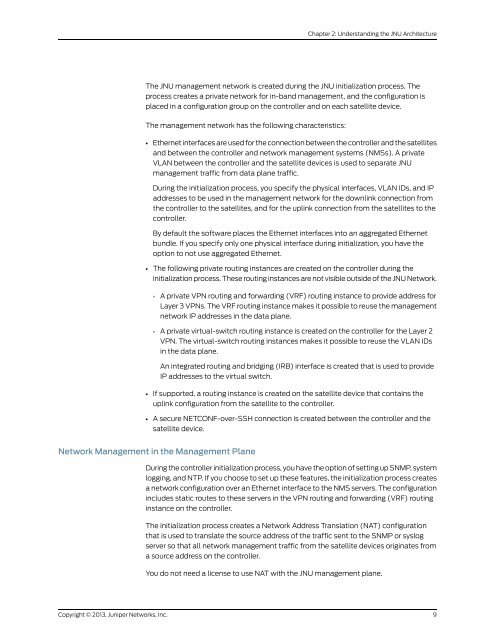Designing and Implementing a Junos Node Unifier Network
Designing and Implementing a Junos Node Unifier Network
Designing and Implementing a Junos Node Unifier Network
Create successful ePaper yourself
Turn your PDF publications into a flip-book with our unique Google optimized e-Paper software.
The JNU management network is created during the JNU initialization process. The<br />
process creates a private network for in-b<strong>and</strong> management, <strong>and</strong> the configuration is<br />
placed in a configuration group on the controller <strong>and</strong> on each satellite device.<br />
The management network has the following characteristics:<br />
• Ethernet interfaces are used for the connection between the controller <strong>and</strong> the satellites<br />
<strong>and</strong> between the controller <strong>and</strong> network management systems (NMSs). A private<br />
VLAN between the controller <strong>and</strong> the satellite devices is used to separate JNU<br />
management traffic from data plane traffic.<br />
During the initialization process, you specify the physical interfaces, VLAN IDs, <strong>and</strong> IP<br />
addresses to be used in the management network for the downlink connection from<br />
the controller to the satellites, <strong>and</strong> for the uplink connection from the satellites to the<br />
controller.<br />
By default the software places the Ethernet interfaces into an aggregated Ethernet<br />
bundle. If you specify only one physical interface during initialization, you have the<br />
option to not use aggregated Ethernet.<br />
• The following private routing instances are created on the controller during the<br />
initialization process. These routing instances are not visible outside of the JNU <strong>Network</strong>.<br />
• A private VPN routing <strong>and</strong> forwarding (VRF) routing instance to provide address for<br />
Layer 3 VPNs. The VRF routing instance makes it possible to reuse the management<br />
network IP addresses in the data plane.<br />
• A private virtual-switch routing instance is created on the controller for the Layer 2<br />
VPN. The virtual-switch routing instances makes it possible to reuse the VLAN IDs<br />
in the data plane.<br />
An integrated routing <strong>and</strong> bridging (IRB) interface is created that is used to provide<br />
IP addresses to the virtual switch.<br />
• If supported, a routing instance is created on the satellite device that contains the<br />
uplink configuration from the satellite to the controller.<br />
• A secure NETCONF-over-SSH connection is created between the controller <strong>and</strong> the<br />
satellite device.<br />
<strong>Network</strong> Management in the Management Plane<br />
Copyright © 2013, Juniper <strong>Network</strong>s, Inc.<br />
During the controller initialization process, you have the option of setting up SNMP, system<br />
logging, <strong>and</strong> NTP. If you choose to set up these features, the initialization process creates<br />
a network configuration over an Ethernet interface to the NMS servers. The configuration<br />
includes static routes to these servers in the VPN routing <strong>and</strong> forwarding (VRF) routing<br />
instance on the controller.<br />
The initialization process creates a <strong>Network</strong> Address Translation (NAT) configuration<br />
that is used to translate the source address of the traffic sent to the SNMP or syslog<br />
server so that all network management traffic from the satellite devices originates from<br />
a source address on the controller.<br />
Chapter 2: Underst<strong>and</strong>ing the JNU Architecture<br />
You do not need a license to use NAT with the JNU management plane.<br />
9
















